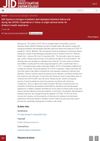Search
for
Sort by
Research
90-120 / 1000+ resultsresearch Androgenetic Alopecia in China: A Survey in Six Provinces

research Prevalence of Androgenetic Alopecia in China: A Community-Based Study in Six Cities
Baldness is more common in Chinese men than women, increasing with age, and is influenced by genetics.

research Design of a Multifunctional Biomaterial Inspired by Ancient Chinese Medicine for Hair Regeneration in Burned Skin
The new biomaterial inspired by ancient Chinese medicine effectively promotes hair growth and heals wounds in burned skin.

research Comparing the Risk of Adverse Pregnancy Outcomes of Chinese Patients with Polycystic Ovary Syndrome with and without Antiandrogenic Pretreatment
Women with PCOS who had antiandrogenic treatment before pregnancy had fewer complications than those without treatment.

research Metformin Improved Health-Related Quality of Life in Ethnic Chinese Women with Polycystic Ovary Syndrome
Metformin helped improve the quality of life for Chinese women with PCOS, especially in physical health and symptoms like infertility, acne, and hair loss.

research Prevalence of Dermatologic Manifestations and Metabolic Biomarkers in Women with Polycystic Ovary Syndrome in North China
Women with PCOS in North China often have hirsutism and acne, with hirsutism linked to metabolic issues.

research Determining the Normal Cut-Off Levels for Hyperandrogenemia in Chinese Women of Reproductive Age
Normal levels for certain hormones in Chinese women of reproductive age were identified.

research Symmetrical Acrokeratoderma: A Peculiar Entity in China? Clinicopathologic and Immunopathologic Study of 34 New Cases
Symmetrical Acrokeratoderma (SAK) may be a unique skin condition in China, lacking specific treatment and needing long-term monitoring.
research General Adverse Response to Cyclophosphamide in Chinese Patients with Systemic Autoimmune Diseases in Recent Decade: A Single-Center Retrospective Study
Cyclophosphamide often causes gastrointestinal issues, hair loss, and low blood cell counts in Chinese patients with autoimmune diseases.

research Early-Onset Androgenetic Alopecia in China: A Descriptive Study of a Large Outpatient Cohort
Early hair loss common in Chinese males, linked to family history and smoking; early treatment advised.

research Frontal Pattern Hair Loss Among Chinese Women Is Frequently Associated With Ponytail Hairstyle
Wearing a ponytail often is linked to hair loss at the front of the scalp in Chinese women.

research Evidence of the Moderating Role of Hair Cortisol and Hair Cortisone in the Relationship Between Work Stress and Depression Symptoms Among Chinese Fishermen
Hair cortisol and cortisone levels may affect how work stress influences depression in Chinese fishermen.
research Atrichia With Papular Lesions in a Chinese Family Caused by Novel Compound Heterozygous Mutations and Literature Review
New genetic mutations causing hair loss were found in a Chinese family.
research A New Clinical Variant of Hereditary Localized Alopecia: Report of a Chinese Family Mapped to Chromosome 2p25.1–2p23.2
A new type of hereditary hair loss in a Chinese family is linked to chromosome 2p25.1–2p23.2.
research Case Report: NUDT15 Polymorphism and Severe Azathioprine-Induced Myelosuppression in a Young Chinese Female with Systemic Lupus Erythematosus: A Case Analysis and Literature Review
Genetic screening for NUDT15 polymorphisms is crucial for patients taking azathioprine, especially in Asians.

research Epidemiology and Disease Burden of Androgenetic Alopecia in College Freshmen in China: A Population-Based Study
Hair loss is more common in male Chinese college freshmen, and it's linked with rosacea but doesn't affect their quality of life.

research Confirmatory Factor Analysis of the Causal Illness Attribution Scale in Chinese Patients with Multiple Somatic Symptoms
The two-factor model fits better for Chinese patients' understanding of illness causes than the original four-factor model.

research Combination of Western Medicine and Traditional Chinese Medicine for Treatment of Malignant Bone and Soft Tissue Tumors
Combining Western chemotherapy with Traditional Chinese Medicine can reduce side effects and improve immune response in treating bone and soft tissue tumors.

research Malassezia Species Overgrowth in a Chinchilla Cat
The cat's skin condition improved with treatment, but underlying health issues must be addressed.

research Long-Hair Follicular Unit Excision Enhances the Cosmetic Results of Hairline Restoration: A Retrospective Study in Chinese Recipients
Long-hair follicular unit excision improves hairline restoration results and patient satisfaction.

research Spectrum Changes of Pediatric Dermatological Disorders Before and During the COVID-19 Pandemic in China: A Single National Center for Children's Health Experience
During the COVID-19 pandemic in China, skin conditions like eczema and warts increased among children, while respiratory-transmitted skin infections decreased, partly due to mask-wearing.

research Genome-Wide Association Studies for Immunoglobulin Concentrations in Colostrum and Serum in Chinese Holstein
Certain genes influence immunoglobulin levels in Chinese Holstein cows, which can improve calf health.

research Patentability of Dosage Regime Invention in the Form of Swiss-Type Claim Under Chinese Patent Law
Dosage regime inventions can be patentable in China, but legal uncertainty exists.

research Profile of Alopecia Areata in 655 Chinese Patients
Most patients with alopecia areata in China have patchy hair loss, with total hair loss being less common, and the condition often starts around age 35 and can negatively affect quality of life, especially in more severe cases.
research The Effect of Melatonin Treatment on Hair Follicle Activity in Growing Chinchillas
Melatonin boosts hair growth in chinchillas.
research Epidemiology and Disease Burden of Androgenetic Alopecia in Chinese Adolescents: A Population-Based Study
Androgenetic alopecia is more common in male Chinese adolescents and linked to rosacea, but doesn't affect quality of life.